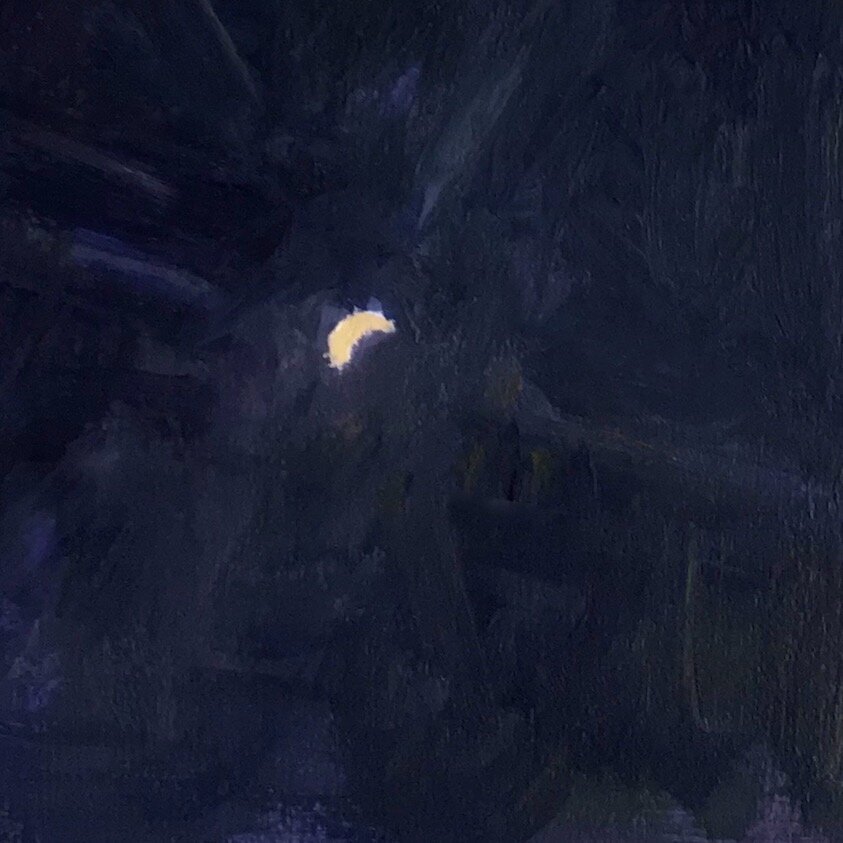Planet Venus 2020 acrylic on card 12 x 12cm
The image of Venus appears upside down due to the optics of the telescope.
Not long ago I purchased an inexpensive 5-inch Newtonian reflector telescope to get a closer look at the lunar surface and the planets, including the dazzling Venus riding high in the sky after sunset. Even with modest magnification the planet appeared as a beautiful crescent shaped moon in miniature, made of smooth white marble. After various cack-handed attempts to capture it with a smartphone camera I decided to make a painting instead whilst looking through the eyepiece. I have plenty of experience creating paintings in the dark but producing one with the aid of a telescope was a first for me. As I worked quickly I made adjustments to the scope every thirty seconds because the planet constantly drifted out of view (I had yet to attach the motorised EQ mount device) but the opportunity to capture this fleeting earth-sized planet in paint was not to be missed.
The moon rises over a building, accompanied by the planet Jupiter. Detail of Housing Estate near Old Kent Road 2016 acrylic on board
The moon has often featured in my work, usually as a glowing orb, but there was one occasion when it was accompanied closely in the sky by the planet Jupiter, rising above an earth based landscape of a housing estate in south east London. The immense scale of space is hard to visualise as the gas giant Jupiter appears as a small flat dot when placed alongside a much larger but equally flat moon.
Damian Hirst Calibration Target for Beagle 2 Mars Lander British Space Mission 2003, natural pigments on aluminium 9 x 76 x 76 mm (Image: damianhirst.com)
Art and science have always collaborated together in the search for knowledge and revelation, often in direct and novel ways. In the era of ‘Cool Britannia’, artist Damian Hirst’s Spot Painting was used as a practical device (alongside a sound recording by Brit-pop band Blur) for the ill-fated Beagle 2 Mars lander in 2003. Hirst’s work would have served as a colour calibration chart for the craft’s equipment to measure against the natural colours of the Martian landscape. Though the mission was ultimately lost, Hirst’s spot painting is the first artwork to land on another planet. This direct relationship between art and science also works the other way around: Consider Apollo 12 astronaut Alan Bean who made it a lifelong post-mission ‘mission’ to paint his memories of the lunar surface (seemingly after feeling guilty for having burnt out the live picture colour camera on the moon by accidentally pointing it at the sun!)
Hannah Pratt Hercules and the Dragon embroidery on printed canvas (Image: hannahprattartist.com)
Art is important in visualising the invisible, the hidden and the abstract in nature, including astronomy. Artist Hannah Pratt collaborates with scientists by using real data to produce work that is both visually dynamic and scientifically informative. Her round canvases embrace the observable universe with the elemental and the mythical realms. She refers to her work as ‘space craft’, a play on words, as she incorporates sewing into her pieces, complete with embroidery rings as frames. Carefully threaded lines of different colours represent spectroscopy and wavelengths - each star has a colour spectral signature that reveals its chemical composition. Hercules and the Dragon depicts colour coded spectral lines of stars contained in the constellations of Hercules and Draco. These radiated lines are reminiscent of the pulsar diagrams that were launched on board on the Pioneer and Voyager space probes in the 1970s, now the most distant manmade objects from earth.
Venus crescent 2020 acrylic on card 13 x 13cm
Apollo 17 astronaut Gene Cernan said that he saw the earth sitting in a star field in space. His statement is an incredible first hand experience of a different frame of reference, rather like spotting one’s hometown from an aeroplane - the familiar seen from an unfamiliar location. We might not grasp the immensity of that but it’s thanks to artists and scientists who can open the eyes and mind to the splendours of the cosmos.




